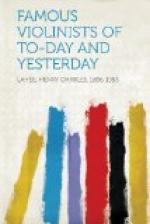CHAPTER VII.
1830 TO 1850.
One of the most noticeable features of the biography of the violin virtuoso is that he invariably displays great talent at an early age and plays in public at any time from eight to twelve years old. There are doubtless more who do this than are ever heard of at a later day, for the idea of the infant phenomenon is alluring. The way of the violinist is hard. He has many years of study and self-denial before him, if he is to excel as a musician. Therefore the infant who can be exploited in such a manner as to make money provides for his future education, unless hard work or flattery kill him physically or intellectually before he is ripe. Many prodigies sink into oblivion,—some few rise to celebrity. It will be noticed that the violinists who played in public while very young have invariably settled down afterward to serious study, and at a more mature age have thus been able to take their place in the musical world.
Year by year, too, the demands upon the violinist have been greater. A virtuoso is judged rather by the standard of Beethoven’s concerto than by his ability to perform musical gymnastics with operatic selections. Nevertheless, it is a fact that many of the best known violinists were those who catered to the taste of the multitude, while many better musicians have been comparatively unknown.
Among celebrated violinists few have led more romantic or adventurous lives than Edouard Remenyi, whose name is not yet forgotten in this country. Born at Hewes, in Hungary, in 1830, he possessed the restless spirit of his race, fought in the insurrection of 1848, escaped to the United States when the insurrection was crushed, but was received into favour again a few years later, on his return to his native land.
From his twelfth to his fifteenth year he studied the violin at the Vienna Conservatoire under Boehm, who was also the teacher of Joachim. In 1848 he became adjutant to the distinguished General Goergey, and fought under Kossuth and Klapka in the war with Austria. Then came the flight to America, where he made a tour as a virtuoso, but in 1853 he visited Weimar, and sought out Franz Liszt, who at once recognised his genius and became his friend and guide.




